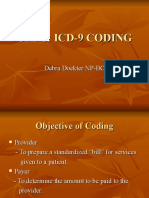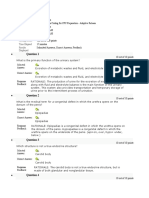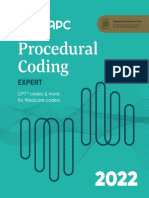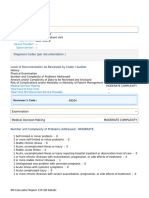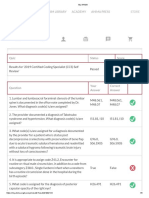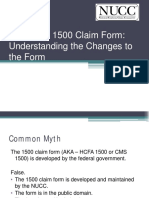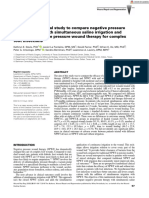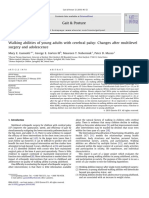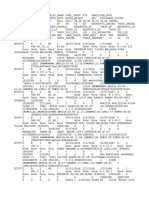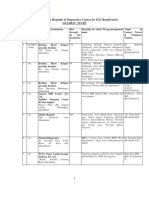Basic Inpatient E/M Coding
Training
By: Khalid Sakhi
�Outline
This training only covers the basic elements of coding for inpatient evaluation and
management (E/M) services, specifically initial hospital visits, subsequent hospital visits,
discharge services, observations, inpatient consultations, coding based on time, and
prolonged services.
Components of E/M Services
Inpatient E/M Inpatient Services
Initial Hospital Visits
Subsequent Hospital Visits
Hospital Discharge Services
Hospital Observation Services
Inpatient Consultations
When to Use Time Based Coding
Prolonged Services
Most Frequently Used Modifiers
Selecting, Sequencing and Linking Diagnosis Codes
Completing Fee Tickets
Teaching Physician Attestations for E/M Services
2
�Components of E/M Inpatient Services
Inpatient E/M services have the same basic components as outpatient E/M.
Below are the basic components:
History
Chief Complaint
History of Present Illness (HPI)
Review of Systems (ROS)
Past Medical, Family, Social History (PFSH)
Examination
Medical Decision-Making (MDM)
Number of diagnoses or management options
Amount and/or complexity of data reviewed or ordered
Risk of complications and/or morbidity or mortality
�Overview of Inpatient E/M Leveling
The codes listed in the left hand column require 3 of 3 components be met or exceeded.
History
Code
99221
99222
Type
PF
EPF
Initial
Hospital
Visit
Detailed
99219
Observation
Services
99235
99236
99251
99252
Hospital Observation or
Inpatient Care Services
(Including Same Day
Admission and
Discharge)
Inpatient
Consultations
99253
PF
EPF
Medical Decision-Making
Detailed
Comp
X
X
99220
99234
Comp
99223
99218
Exam
X
X
X
X
X
X
X
X
X
99255
X
C = Comprehensive
S = Straightforward
Avg. Time
30
50
X
X
70
NA
NA
X
NA
NA
NA
X
NA
20
40
X
EPF = Expanded Problem Focused
99254
PF = Problem Focused
Time Based
55
X
80
X
L = Low
M = Moderate
110
H = High
Notes:
Codes 99221, 99218, and 99234 can either have straightforward or low medical decision-making.
See slide 21 for information on when and how to code based on time.
4
�Overview of Inpatient E/M Leveling
The codes listed in the left hand column require 2 of 3 components be met or exceeded; 1
of the 2 must be medical decision-making.
History
Code
99231
Type
PF
Subsequent
(Follow-up)
Visit
99232
EPF
Detailed
Exam
Comp
EPF
Detailed
PF = Problem Focused
Comp
99233
PF
Medical Decision-Making
EPF = Expanded Problem Focused
S = Straightforward
25
L = Low
Avg. Time
15
C = Comprehensive
Time Based
M = Moderate
35
H = High
Notes:
Code 99231 can either have straightforward or low medical decision-making.
See slide 31 for information on when and how to code based on time.
�Overview of Inpatient Visits
Subsequent follow-up or
encounter by provider
other than admitting
physician:
Initial hospital care:
Admit to
hospital as
inpatient
*Code 99221, 99222
or 99223
Code 99231, 99232 or
99233
Hospital Discharge
Day Management:
Code 99238 or 99239
Inpatient consults:
Code 99251, 99252,
99253, 99254, or 99255
Admission & discharged
on same calendar date:
*Code 99234, 99235 or
99236
Notes: See slides 4-5 and 8-17 for more information on when and how to use these codes.
*For Medicare and CareLink patients, see slides 7 and 16 for information on when
and how to use these codes because these payors have different coding
guidelines.
Prior to admission, patient may have been evaluated at another site of service
(e.g., outpatient hospital, office, emergency department, or nursing facility).
6
�Overview of Inpatient Visits - Medicare & CareLink
Admission < 8 hours:
Code 99221, 99222 or 99223
Admission > 8 hours but < 24 hours &
discharged on same calendar date as
admission:
Code 99234, 99235 or 99236
Admit to hospital as inpatient
Admission > 24 hours:
Code 99221, 99222 or 99223
Subsequent visit by admitting
physician or visit by provider other
than admitting physician:
Code 99231, 99232 or 99233
Hospital Discharge
Day Management:
Code 99238 or 99239
Inpatient consults:
Code 99251, 99252, 99253, 99254,
or 99255
Notes: See slides 4-5 and 8-17 for more information on when and how to use these codes.
Prior to admission, patient may have been evaluated at another site of service
(e.g., outpatient hospital, office, emergency department, or nursing facility).
7
�Initial Hospital Visits
Codes 99221-99223 are used by the admitting physician to report initial services to
hospital inpatients. These codes are often referred to as the Admit codes.
Code
99221-99223 +
99238-99239
99221-99223 +
99231-99233 +
99238-99239
Type
Initial Hospital Visit +
Hospital Discharge Day Management
Initial Hospital Visit +
Subsequent Hospital Visit +
Hospital Discharge Day Management
1st calendar day - admitted
+
3rd calendar day - discharged
1st calendar day - admitted
+
2nd or subsequent calendar days
+
3rd calendar day - discharged
Code both services
Code all services
Duration of Service
Comments
Notes:
Only one physician can be the admitting physician and only the admitting physician
can use codes 99221-99223.
All other providers should bill the inpatient E/M codes that describe their participation
in the patients care (i.e., subsequent hospital visit or inpatient consultation).
When performed on the same date as the admission, all other outpatient services
provided by the physician in conjunction with that admission are considered part of
the initial hospital care.
If the patient is seen in the office on one day, and admitted on the next day (even if
<24 hours have elapsed) by the same physician, code both the office visit and initial
hospital visit.
8
�Initial Hospital Visits
History, exam, and medical decision-making must meet or exceed the same level in
order to assign a specific code (i.e., 3 out of 3 same level or higher).
Code
History
Exam
Medical Decision Making
Comments
99221
Detailed or
comprehensive
Detailed or
comprehensive
Straightforward or low
Usually presenting problem(s)
are of low severity
99222
Comprehensive
Comprehensive
Moderate
Usually presenting problem(s)
are of moderate severity
99223
Comprehensive
Comprehensive
High
Usually presenting problem(s)
are of high severity
�Initial Hospital Visit - Clinical Example
The below clinical example was taken from the current CPT manual and does
not encompass the entire scope of medical practice or the documentation
required to support the code.
The intent of the example is to assign a code level for an initial hospital visit
based on patients presenting problem.
Initial hospital visit for a 50 year old patient with lower quadrant
abdominal pain and increased temperature, but without septic picture.
Based on this example, what code should be assigned? For the answer, see
the next slide.
10
�Initial Hospital Visit - Clinical Example
Based on the example in the preceding slide, the service provided and
documented should support initial hospital visit code 99222.
11
�Subsequent Hospital Visits
Codes 99231-99233 can be used by any provider to report subsequent inpatient services.
Two out of 3 components of history, exam, and medical decision-making must meet or
exceed the same level to assign a code (1 of the 2 has to be medical decision-making).
Code
History
Exam
Medical Decision Making
Comments
99231
Problem focused
Problem focused
Straightforward or low
Usually patient is stable, recovering, or improving
99232
Expanded problemfocused
Expanded
problem-focused
Moderate
Usually patient is responding inadequately to therapy or experiencing a minor
complication
99233
Detailed
Detailed
High
Usually patient is unstable or has developed a significant complication or
significant new problem
Notes:
The descriptors for these codes include the phrase per day, meaning care for the
day.
If Provider A sees the patient in the morning and Provider B, who is covering for
A, sees the same patient in the evening, the notes for both services are combined
and only one subsequent hospital visit is coded.
If two physicians see the patient and they are in different specialties and are
seeing the patient for different reasons (i.e., different diagnosis), then both may
bill a subsequent hospital visit based on that physicians note and the medical
necessity of the service.
Select a code that reflects all services provided during the date of service.
12
�Subsequent Hospital Visits - Clinical Example
The below clinical example was taken from the current CPT manual and does
not encompass the entire scope of medical practice or the documentation
required to support the code.
The intent of the example is to assign a code level for an initial hospital visit
based on patients presenting problem.
Subsequent hospital visit for 55 year old male with severe chronic
obstructive pulmonary disease and bronchospasm; initially admitted for
acuter respiratory distress requiring ventilator support in the ICU. The
patient was stabilized, extubated and transferred to the floor, but has not
developed acute fever, dyspnea, left lower lobe rhonchi and laboratory
evidence of carbon dioxide retention and hypoxemia.
Based on this example, what code should be assigned. For the answer, see
the next slide.
13
�Subsequent Hospital Visits - Clinical Example
Based on the example in the preceding slide, the service provided and
documented should support initial hospital visit code 99233.
14
�Observation or Inpatient Hospital Care
(Including Admission and Discharge Services)
Codes 99234-99236 are used by a provider to report observation or inpatient hospital care
services provided to patients admitted and discharged on the same date of service.
Code
History
Exam
Medical Decision Making
Comments
99234
Detailed or
comprehensive
Detailed or
comprehensive
Straightforward or low
Usually problem(s) requiring admission are of low severity
99235
Comprehensive
Comprehensive
Moderate
Usually problem(s) requiring admission are of moderate
severity
99236
Comprehensive
Comprehensive
High
Usually problem(s) requiring admission are of high severity
Notes:
When performed on the same date as the admission, all other outpatient services
provided by the physician in conjunction with that admission are considered part of the
initial hospital or observation care.
When a patient is admitted to observation or inpatient care and discharged on a
different date, see slides 4, 6-11 and 17 for information on when and how to use the
initial hospital care codes 99221-99223 and discharge management codes 9923899239, or slides 18-25 on when and how to use hospital observation codes 9921899220 and observation care discharge code 99217.
15
�Observation or Inpatient Hospital Care Medicare
and CareLink
Codes 99234-99236 are used by a provider to report:
Admitting and discharging a patient on the same calendar day for >8 hours but <24 hours,
or
Placing a patient under observation and discharging the patient on the same calendar
date for >8 hours but <24 hours
Code
History
Exam
Medical Decision Making
Comments
99234
Detailed or
comprehensive
Detailed or
comprehensive
Straightforward or low
Usually problem(s) requiring admission are of low severity
99235
Comprehensive
Comprehensive
Moderate
Usually problem(s) requiring admission are of moderate
severity
99236
Comprehensive
Comprehensive
High
Usually problem(s) requiring admission are of high severity
Notes:
In addition to meeting the documentation requirements for history, exam and medical
decision-making, documentation in the medical record should include:
Statement that the stay for observation care or inpatient hospital care involved
eight hours, but less than 24 hours.
Admission and discharge notes written by the billing provider.
Personal documentation by the billing provider indicating presence and face-toface services were provided.
16
�Hospital Discharge Day Management
Codes 99238-99239 are used to report the total duration of time spent by the provider
for final hospital discharge services.
History
99238
Hospital discharge day management, 30 minutes or less
99239
Hospital discharge day management, more than 30 minutes
Comments
Face-to-face time between the attending and
the patient
Notes:
Only one hospital discharge service is coded per patient, per hospital stay.
Only the attending physician of record reports the discharge day code.
Discharge service is billed on the date of the actual visit by the provider even if the
patient is discharged on a different calendar date.
Includes, as appropriate:
Final patient exam
Discussion of the hospital stay
Instructions for continuing care
Preparation of discharge records, prescriptions, and referral forms
Total time of the visit must be documented to support code assigned.
All other providers performing a final visit should code subsequent hospital care
(9923199233).
17
�Hospital Observation Services
Subsequent visit by
admitting physician or
visit by another
provider
Admit to
Observation
Status*
Initial observation
care:
Codes 99218,
99219 or 99220
Admission & discharged
on same calendar date:
Code 99212, 99213,
99214, or 99215
Outpatient
consultation: Code
99241, 99242,
99243, 99244, or
99245
Then use discharge
code 99217
Then admit as
inpatient:
Code 99221-99223
(see slides 8-11)
*Code 99234, 99235 or
99236
Notes:
See slides 20-25 for more information on when and how to use these codes.
*For Medicare and CareLink patients, see slides 19 and 21 for information on when
and how to use these codes because these payors have different coding guidelines.
Prior to observation, patient may have been evaluated at another site of service
(e.g., outpatient hospital, office, emergency department, or nursing facility).
18
�Hospital Observation Services Medicare and CareLink
In Observation < 8 hours and
discharged same calendar date:
Code 99218, 99219 or 99220
Admit to
Observation
Status
In Observation > 8 hours but
< 24 hours and discharged
same calendar date:
Code 99234, 99235 or 99236
(see slide 15)
In Observation > 24 hours:
Code 99218, 99219 or 99220
When discharged, use
observation care
discharge day
management: Code
99217
In Observation > 48 hours:
Code 99218, 99219 or 99220
then 99212-99215
If admitted, use initial
hospital visit:
Code 99221, 99222 or
99223 (see slides 8-11)
Notes:
See slides 20-25 for more information on when and how to use these codes.
Prior to observation, patient may have been evaluated at another site of service
(e.g., outpatient hospital, office, emergency department, or nursing facility).
19
�Hospital Observation Services
These codes are used to report a patient placed under observation and include initiation
of observation status, supervision of care, and periodic assessments.
Code
99218-99220 +
99217
99218-99220 +
99212-99215 +
99217
99218-99220 +
99212-99215 +
99221-99223
Type
Initial Observation Care
+
Observation Care Discharge Services
Initial Observation Care
+
Established Patient, Office or other
Outpatient Visit
+
Observation Care Discharge Services
Initial Observation Care
+
Established Patient, Office or other
Outpatient Visit
+
Initial Hospital Visit
1st calendar day - placed under
observation
+
2nd calendar day - discharged
1st calendar day - placed under
observation
+
2nd calendar day - subsequent service
+
3rd calendar day - discharged
1st calendar day - placed under observation
+
2nd calendar day - subsequent service
+
3rd calendar day - admitted to inpatient
status
Code both services
Code all services
Code all services
Duration of Service
Comments
Notes:
Billed only by the physician who admitted the patient to observation and was responsible for the
patient during his/her stay.
All other providers should bill the outpatient E/M codes that describe their participation in the
patients care (i.e., office and other outpatient service codes or outpatient consultation codes).
20
�Hospital Observation Services Medicare and CareLink
These codes are used to report a patient placed under observation and include initiation
of observation status, supervision of care, and periodic assessments.
Code
99218-99220
99234-99236
99218-99220 +
99217
99218-99220 +
99212-99215 +
99217
99218-99220 +
99212-99215 +
99221-99223
Type
Initial Observation
Care
Observation or Inpatient
Care Services
(Including Same Day
Admission and Discharge)
Initial Observation Care
+
Observation Care
Discharge Services
Initial Observation Care
+
Established Patient, Office or
other Outpatient Visit
+
Observation Care Discharge
Services
Initial Observation Care
+
Established Patient, Office or
other Outpatient Visit
+
Initial Hospital Visit
Duration of
Service
Placed under
observation with
discharge on different
calendar date
or
Under observation <8
hours and discharged
on same calendar
date
Placed under observation
and discharged on same
calendar date
for >8 hours but <24 hours
>48 hours:
1st calendar day - placed
under observation
+
2nd calendar day discharged
>48 hours:
1st calendar day - placed
under observation
+
2nd calendar day subsequent service
+
3rd calendar day - discharged
>48 hours:
1st calendar day - placed under
observation
+
2nd calendar day - subsequent
service
+
3rd calendar day admitted to
inpatient status
Comments
Do not also code a
discharge day service
if observation was <8
hours
Do not also code a
discharge day service
See slide 10 for information
on when and how to use
these codes.
Code both services
Code all services
Code all services
Notes:
Billed only by the physician who admitted the patient to observation and was responsible for the
patient during his/her stay.
All other providers should bill the outpatient E/M codes that describe their participation in the
patients care (i.e., office and other outpatient service codes or outpatient consultation codes).
21
�Hospital Observation Services
History, exam, and medical decision-making must meet or exceed the same level in order
to assign a specific code (i.e., 3 out of 3 same level or higher).
Code
History
Exam
Medical Decision Making
Comments
99218
Problem focused
Problem focused
Straightforward or low
Usually patient is stable, recovering, or improving
99219
Expanded problemfocused
Expanded problemfocused
Moderate
Usually patient is responding inadequately to therapy or experiencing a minor
complication
99220
Detailed
Detailed
High
Usually patient is unstable or has developed a significant complication or
significant new problem
Notes:
The descriptors for these codes include the phrase per day, meaning care for the
day.
Select a code that reflects all services provided during the date of the service.
The observation record for the patient must contain dated and timed physicians
admitting orders regarding the care the patient is to receive while in observation, and
progress notes prepared by the physician while the patient was in observation status.
This information is in addition to any record prepared as a result of an emergency
department, outpatient clinic, or nursing facility encounter.
In rare instances when a patient is held in observation status for more than two
calendar dates, the physician must code subsequent services before the discharge
date using outpatient/office visit codes (99212-99215).
22
�Observation Care Discharge Services
Code 99217 is used to report discharge services of a patient in observation status.
History
99217
Observation care discharge day management
Comments
Face-to-face time between the attending and
the patient
Notes:
Billed only by the physician who was responsible for observation care during this stay.
Discharge service is billed on the date of the actual visit by the provider .
Includes:
Final patient exam
Discussion of the hospital stay
Instructions for continuing care
Preparation of discharge records, prescriptions, and referral forms
All other providers performing a final visit should use outpatient/office visit codes (9921299215).
Do not bill the hospital observation discharge management code (99217) if patient was
Admitted to inpatient status, use codes 99221-99223. See slide 8-11 for more
information on when and how when and how to use these codes.
Placed under observation and discharged on the same calendar date, use codes
99234-99236. See slide 15-16 for information when and how to use these codes.
23
�Hospital Observation During A Global Surgical
Period
The global surgical fee includes payment for hospital observation (codes 99217,
99218, 99219, 99220, 99234, 99235 and 99236) services unless specific
requirements are met.
Observation services may be paid in addition to the global surgical fee only if both of
the following requirements are met:
The hospital observation service meets the criteria needed to justify billing it with
modifiers:
24 - Unrelated E/M service by the same physician during a post-operative
period
25 - Significant, separately identifiable E/M service by the same physician on
the same day of a procedure or other service
57 - Decision for major surgery
The hospital observation service furnished by the surgeon meets all the criteria
for the hospital observation code billed.
See slide 35 for information on when and how to use modifiers with E/M
services.
24
�How to Use Observation Codes - Examples
Date
9/18
9/18
Medicare & CareLink
Admitted to Observation by Provider A on 9/18 at 1AM;
seen and discharged by Provider A at 7 AM on 9/18
99234-99236
(Provider A)
99218-99220
(Provider A)
Admitted to Observation by Provider A on 9/18 at 1AM;
seen and discharged by Provider A at 9/18 4PM
99234-99236
(Provider A)
99234-99236
(Provider A)
99218-99220
(Provider A)
99212-99215
(Provider B)
99218-99220
(Provider A)
99212-99215
(Provider B)
99217
(Provider A)
99218-99220
(Provider A)
99212-99215
(Provider A)
99217
(Provider A)
99218-99220
(Provider A)
99212-99215
(Provider A)
99221-99223
(Provider A)
Admitted to Observation by Provider A on 9/18 at 1AM;
seen by Provider B 9/18 at 3 PM; seen and discharged
on 9/19 at 7 AM by Provider A
Note: Provider A is from a different specialty than
Provider B and the service was not a
consultation.
Admitted to Observation by Provider A on 9/18 at 1AM;
seen by Provider A on 9/19; and, seen and discharged
by Provider A on 9/20
99218-99220
(Provider A)
Admitted to Observation by Provider A on 9/18 at 1AM;
seen by Provider A on 9/19; and, admitted by Provider
A to inpatient status 9/20
99218-99220
(Provider A)
9/19
9/20
25
�Inpatient Consultations
Codes 99241-99245 are used to report consultations provided to hospital inpatients.
History, exam, and medical decision-making must meet or exceed the same level in order
to assign a specific code (i.e., 3 out of 3 same level or higher).
Code
History
Exam
Medical Decision Making
Comments
99251
Problem focused
Problem focused
Straightforward
Usually presenting problem(s) are self
limited or minor
99252
Expanded problem-focused
Expanded problem-focused
Straightforward
Usually presenting problem(s) are of low
severity
99253
Detailed
Detailed
Low
Usually presenting problem(s) are of
moderate severity
99254
Comprehensive
Comprehensive
Moderate
Usually presenting problem(s) are of
moderate to high severity
92255
Comprehensive
Comprehensive
High
Usually presenting problem(s) are of
moderate to high severity
Notes:
An inpatient consultation may only be billed once per consultant, per admission.
Additional follow-up visits after the initial inpatient consultation are billed using the
subsequent hospital care codes (99231-99233). See slide 12-14 for information on
when and how to use these codes.
A request to take care of the problem is a referral, and should be coded with
subsequent hospital care code 99231-99233. See slide 12-14 for more information
on when and how to use these codes.
26
�Inpatient Consultations
These requirements must be met and supported by documentation in the patients
inpatient medical record to code and bill a consultation.
The service is provided by a physician or qualified non-physician provider whose
opinion or advice regarding evaluation and/or management of a specific problem is
requested by provider (excludes residents, fellows, and interns) due to the
consultants expertise in a specific medical area beyond the requesting providers
knowledge; and,
The request for a consultation including the name of the requestor and the need or
reason for the consultation must be documented by the consultant in the inpatients
medical record; and,
After the consultation is provided, a written report of the consultants findings,
opinions, and recommendations is documented in the inpatient record for the
requesting provider to use in the management of and/or decision making for the
patient; and,
Intent is to return the patient to requesting provider for ongoing care of the problem.
During the service, the consultant may:
Perform or order diagnostic tests, or
Initiate a treatment plan, including performing emergent procedures.
27
�Examples of Disposition Boxes for Consultation
Services Templates
Here are examples that you may include in your documentation templates to support your
intent to return the patient to the requestor.
Return to requesting provider with recommendations and treatment options.
Return to requesting providers care with final recommendations after completion of
additional diagnostic testing.
Return to requesting providers care with final recommendations after evaluation of
trial of therapeutic regimen.
Will follow for X problems in parallel with requesting provider if provider agrees.
28
�Inpatient Consultations - Clinical Example
The below clinical example was taken from the current CPT manual and does
not encompass the entire scope of medical practice or the documentation
required to support the code.
The intent of the example is to assign a code level for an initial hospital visit
based on patients presenting problem.
Initial inpatient consultation for a 72 year old male with emergency
admission for possible bowel obstruction.
Based on this example, what code should be assigned. For the answer, see
the next slide.
29
�Inpatient Consultations - Clinical Example
Based on the example in the preceding slide, the service provided and
documented should support initial hospital visit code 99254.
30
�When to Use Time Based Coding
In an inpatient setting, when more than 50% of the total visit time by the teaching
physician is counseling and/or coordinating the patients care, the time used to code
must be provided at the patients bedside and/or on the patients hospital floor or unit.
When coding based on time, the teaching physician may not:
Add time spent by the resident in the absence of teaching physician to face-toface time spent with the patient by the teaching physician with or without the
resident present .
Count time counseling or coordinating the patients care after leaving the patients
floor or after beginning to care for another patient.
In addition to documenting history and/or physical exam provided, the documentation
should include:
Total visit time and time spent counseling and coordinating care, and,
Description of the medical decision making and counseling discussion and/or
activities coordinated.
Examples of documenting support for coding based on time based:
I spent a total of 30 of 45 minutes on the floor coordinating Davids care and in
discussion with David regarding
30 of 40 minutes of visit at Marys beside discussing .with Mary and her family
was spent discussing
31
�Prolonged Services
Codes 99356 and 99357 can be used to report inpatient services involving direct
(face-to-face) care provided beyond the usual E/M service.
Code
E/M Type
Typical Time for Code
Threshold Time to Bill Code 99356
Threshold Time to Bill Code 99357
30
60
105
50
80
125
99223
70
100
145
99231
15
45
90
25
55
100
99233
35
65
110
99251
20
50
95
99252
40
70
115
55
85
130
99254
80
110
155
99255
110
140
185
99221
99222
99232
99253
Initial Hospital Visit
Subsequent Visit
Inpatient Consultation
Note: See slides 33-36 for information on when and how to use these codes.
32
�When to Use Prolonged Service Codes
Only count the duration of direct face-to-face contact between the physician and the patient
(whether the service was continuous or not) beyond the typical/average time of the E/M visit code
billed for the same date of service. See slide 32 for typical and threshold times and applicable E/M
services.
Must be 30 minutes or more beyond the typical time assigned to the E/M level coded
Example: Average time for 99232 = 25 minutes, so a minimum of 55 minutes would be
required to also bill 99356.
Prolonged service of less than 15 minutes beyond the first hour or less than 15 minutes
beyond the final 30 minutes is not reported separately.
Prolonged service of less than 30 minutes total duration on a given date is not separately
reported because the work involved is included in the total work of the E/M codes.
Cannot bill prolonged services:
Based on time spent reviewing charts or discussing a patient with house medical staff
without direct face-to-face contact with the patient, waiting for test results, changes in the
patients condition, end of a therapy, or use of facilities
Without first coding an inpatient E/M service on the same date of service
If the total duration of direct face-to-face time does not equal or exceed the threshold time for
the level of E/M service the provider is billing
When the E/M service is selected based on time, prolonged services may only be reported as the
companion code with the highest code level in that family of codes (i.e., 99223, 99233, or 99255).
See slide 8-14 and 26-30 for information on when and how to bill codes based on time.
33
�Documentation for Prolonged Services
Documentation is required in the medical record about the duration and content of the
medically necessary E/M service and prolonged services billed.
The start and end times of the visit must be documented in the medical record along
with the date of service.
The medical record must be appropriately and sufficiently documented by the
physician or qualified NPP to show that the provider personally furnished the direct
face-to-face time with the patient specified in the CPT code definitions.
34
�Prolonged Services - Clinical Example
The below clinical example was taken from the current CPT manual and does
not encompass the entire scope of medical practice or the documentation
required to support the code.
The intent of the example is to assign a code level for an initial hospital visit
based on patients presenting problem.
A 34 year old primigravida presents to hospital in early labor. Admission
history and physical reveals severe preeclampsia. Physician supervised
management for preeclampsia, IV magnesium initiation and maintenance,
labor augmentation with pitocin, and close maternal-fetal monitoring.
Physician face-to-face involvement includes 40 minutes of continuous
bedside care until the patient is stable, then is intermittent over several
hours until the delivery.
Based on this example, what code should be assigned. For the answer, see
the next slide.
35
�Prolonged Services - Clinical Example
Based on the example in the preceding slide, the service provided and
documented should support initial hospital visit code 99356.
36
�Inpatient Modifiers
These are the most frequently used modifiers with inpatient E/M services. However,
there may be others. See TrailBlazers Modifier manual for a complete listing of other
modifiers at http://www.trailblazerhealth.com/Publications/Manuals/.
24 - Unrelated E/M service by the same physician during a post-operative period.
25 - Significant, separately identifiable E/M service by the same physician on the
same day of a procedure.
57 - Decision for major surgery.
GC - Service performed in part by a resident under direction of a teaching physician.
37
�Tips on Selecting Diagnosis Codes
This information will assist in the selection of diagnosis codes used to bill an E/M service.
Diagnosis codes:
Describe the condition(s) that prompted the visit and support the medical necessity
and level of service coded.
Must be supported by documentation in the current note.
Are coded to the highest degree of specificity (e.g. renal failure vs. chronic kidney
disease, Stage III).
May be taken from final assessment or chief complaint.
Can be based on signs/symptoms if unable to make definitive diagnosis during the
visit.
Cannot be coded for conditions documented as rule out probable...
possiblequestionable.
Include secondary conditions affecting treatment during the current visit.
Diagnosis codes are not assigned when a diagnosis is mentioned in the history and is
not addressed, or there is no indication in the current visit note that the diagnosis
affected care.
38
�Tips on Sequencing Diagnosis Codes
All diagnosis codes must be sequenced (1,2,3, etc.) on the fee ticket.
Sequencing on the fee ticket should follow the same sequence as the diagnosis are
documented in the current visit note.
First-listed code:
Chief complaint (i.e., diagnosis, condition, problem, or other reason for the visit
such as chemotherapy) chiefly responsible for the service provided.
If the reason for the visit was for multiple complaints and each was addressed as
supported by documentation,
The complaint that was most time consuming due to evaluation and/or
management is sequenced first; and,
The remaining complaints are sequenced thereafter based on evaluation
and/or management.
Additional codes:
Newly diagnosed codes that were evaluated and/or treated during the current
service.
Co-morbid conditions that coexist at the time of the service and influence,
require, or affect patient-care or treatment as supported in documentation.
Selecting a diagnosis without sequencing the code is not acceptable.
39
�Example of Linking Diagnosis Codes
to E/M Services and Procedures
The patient was admitted 2 days ago with acute exacerbation of asthma and native
vessel CAD. Today, a painful pilondial cyst was also evaluated and the cyst was
incised and drained. Notes supporting the subsequent hospital visit and I&D were
fully documented in the patients medical record.
Assessment:
Codes:
1.
2.
3.
1.
2.
3.
Asthma with acute exacerbation
Native vessel coronary artery disease
Pilondial cyst without abscess
493.02
414.01
685.1
E/M Service: Subsequent hospital visit
99232-25
1.
2.
3.
493.02
414.04
685.1
Procedures:
Incision and drainage of pilondial cyst, simple
10080
3.
685.1
Notes:
When an E/M service and a procedure are coded for the same visit, diagnosis codes
must be linked to both the E/M service and the procedure.
Applying the appropriate modifier to the E/M and procedure code support the medical
necessity of both services. See slide 37 for information on when and how to assign
E/M modifiers.
40
�Completing A Fee Ticket
Select E/M level
Select additional service or procedure codes as applicable
Select, sequence, and link diagnosis codes for each E/M and procedure coded
Select modifiers
Sign the paper fee ticket or authenticate the electronic fee ticket
41
�Documenting a Teaching Physician Attestation for
E/M Services
The teaching physician does not have to re-perform and re-document the entire E/M
service to bill. However, the teaching physician, at minimum, must personally document
an attestation to supplement the residents documentation.
The attestation includes a statement that the teaching physician:
Personally performed the service, or was physically present during the key or
critical portions of the service when performed by a resident;
Participated in the management of the patient; and,
Reviewed the residents note. The name of the resident should be included in
the attestation.
When properly attested, the residents documentation and the facultys
documentation can be used by the teaching physician to determine the level of E/M
service billed and support medical necessity.
42
�Examples of Teaching Physician Attestations for
E/M Services
Examples of acceptable attestations:
I saw and evaluated the patient. I agree with the findings and plan of care
documented in Dr. Residents note.
I saw the patient with Dr. Resident and agree with his findings and plan.
I saw the patient and discussed the patient with Dr. Resident and agree with the
note except that the findings are more consistent with. Will begin .
Examples of unacceptable attestations:
Discussed with resident and agree.
Patient seen and evaluated.
Agree with the above.
It is also unacceptable for a resident to attest to a teaching physicians presence and
participation in an E/M service.
For example, I saw and evaluated the patient with Dr. Faculty who agrees with
my findings and plan of care.
43

